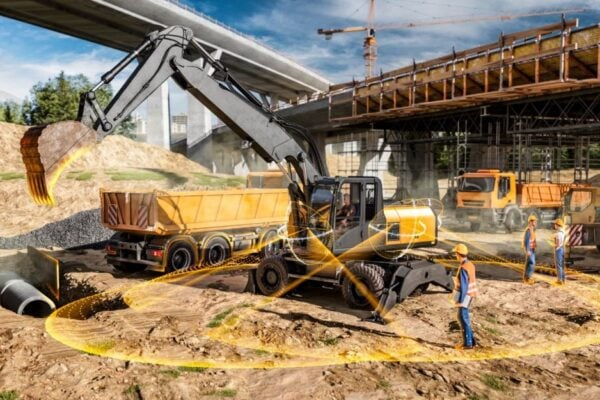Complex electronic equipment with sophisticated sensor arrays to detect the surroundings is not an exclusive feature of road vehicles; construction site or mining vehicles of all kinds now also have such devices. At bauma, the world’s largest trade fair for construction site vehicles currently taking place in Munich, Continental is showing how electronics can improve the safety of construction workers in the vicinity of such machines.
The technology corporation showed an improved version of its ProViu 360 surround view system at the show, which is designed to increase safety in the construction and mining industries. The system contains four HDR cameras with a resolution of 1.3 megapixels. It takes images with an aperture angle of up to 194 degrees which are stitched together by software in the control unit to give a perfect all-round bird’s eye view of the vehicle.
Equipped with the additional feature “Worker Detection”, ProViu can identify persons in the near field of the construction machine and warn the machine operator of collisions. A function called “Transparent Chassis” provides an overview and precision for overhanging machine superstructures. And the “Clean Camera Assistant” detects dirty or blocked camera lenses.
All new features are based on algorithms from car development and have been optimised for use on construction sites. Advantage: Manufacturers and customers thus have access to the latest automotive technologies, and at the same time the hardware setup remains the same.
Worker Detection builds on the work of passenger car development teams for the City Emergency Brake Assist, which Continental developed for road vehicles. Experts for special vehicles have developed a feature for construction machinery on this basis. With the help of an algorithm specially adapted to the unclear conditions of a construction site, people can be recognised in the close range of the construction machine and collisions can thus be prevented. In cooperation with a large OEM, this algorithm was “taught” the specific differences between a road scenario and the situation on the construction site: it thus recognises stones, gravel and sand instead of smooth, grey asphalt surfaces; metal parts, concrete blocks and wooden pallets – an important difference to the relatively smooth and obstacle-free lanes in road traffic. The same applies to the recognition of people in shapeless overalls, helmets and fluttering high-visibility waistcoats instead of high-contrast outlines that can be easily distinguished from the background. This allows the ProViu 360 system to detect when people are in the vicinity of the construction machine and warn the operator to stop the machine or not move it at all.
The second new feature keeps the platform operational, as the associated algorithm alerts the operator when a camera is dirty or blocked and the system can no longer provide all the necessary information. “At first glance, this looks like a rather minor idea,” says Chris Meissner. “But in a dirty and exhausting working day, it is important to help not only in theory. That’s why we wanted to offer the construction and mining industry very concrete support for productivity and safety, in addition to the latest digital technology.”
Another feature that can add great value on construction sites is the Transparent Chassis for particularly protruding construction machines. This feature sends the images of the area in front of the vehicle taken by the front camera to the control unit, which displays the images instead of the vehicle depending on the steering angle and speed, allowing a view virtually through the vehicle. In this way, the machine operator knows where his vehicle is in relation to the working area, for example, during rolling operations that require a particularly high precision.
Another new feature for ProViu 360 is a software function that is particularly helpful for the industrialisation of machines that are manufactured in small batches: Autocalibration. It significantly shortens the implementation time for the ProViu camera systems in production. Instead of manually calibrating the camera system for optimal visibility, an algorithm detects a pattern around the vehicle and determines the best calibration settings for each vehicle within seconds, reducing the vehicle calibration time by several minutes per vehicle. In addition, the auto-calibration feature guarantees repeatable results.



Leave a comment